The Infrared Luminescence technique
for document examination and forgery analysis
Andrew Davidhazy
Imaging and Photographic Technology
School of Photographic Arts and Sciences / RIT
for document examination and forgery analysis
Andrew Davidhazy
Imaging and Photographic Technology
School of Photographic Arts and Sciences / RIT
Infrared photography has become a fairly common application in a variety of fields from straight landscape photography to forensic science and surveillance. This has been made possible by the advent of imaging with CCD equipped digital cameras that have an inherent sensitivity to infrared, those that are further modified by the removal of an infrared blocking filter built-in by the manufacturers and more recently by the introduction of cameras that are made with the express purpose of exploiting the infrared sensitivity of their electronic sensors. There is even one camera that at the flick of a switch can record uncontaminated color records of a scene and also images scenes in infrared.
Photography by reflected infrared rays is really nothing new and it is much like photographing through a color filter. One simply places a filter of the desired color over the camera lens and the resulting record will reflect tonal changes or relationships in the scene that are cause by only those wavelengths allowed by the filter to pass. In short, a red filter appears red because it allows only red wavelengths to pass. In the same way, an infrared filter is called this because it lets infrared rays through but blocks everything else. So visually it looks opaque.
Just like there are "complementary" filters for the primary Red, Green, and Blue filters (these are the Cyan, Magenta and Yellow filters) there is also a similar filter for the infrared filters. It is sometimes referred to as a "hot mirror" because the filter reflects back infrared rays and at others it is called an infrared blocking or absorbing filter. It might be called a "light" filter since it transmits light or wavelengths from 400 to 700 nm but blocks everything else. It has a blue-green look to the eye. A typical filter of this kind is the one designated as Corning 9780 or the very similar 9788.
The consequence of combining a red filter with a cyan one is that all light should be blocked. However, infrared may still be transmitted and an improvised infrared filter may be made from the combination. This is also possible by combining a red filter with a blue one as suggested in this related article. But I digress...
In summary, combining the 9780 with an infrared transmitting filter will block all light and all infrared. It will be truly opaque to just about all radiation.
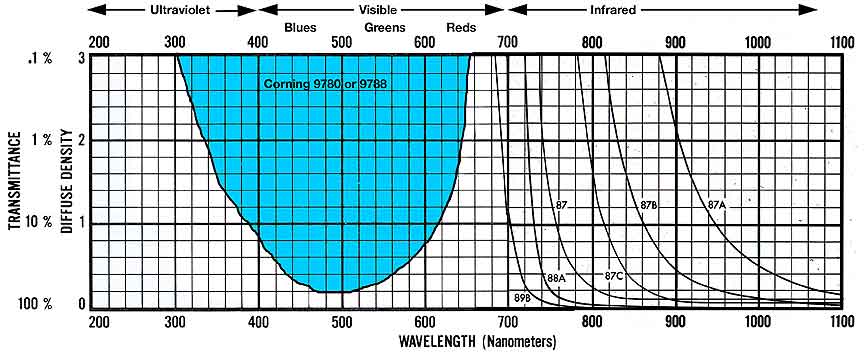
Above are the approximate transmission curves for the filters referred to in this article. Note that the blue-green filters do not pass any infrared. Note that the Wratten Infrared filters are visually opaque and do not transmit any visible wavelengths.
he infrared blocking Corning 9780 or 9788 filters are actually very little known filters in normal photographic circles. But these filters and the complementary infrared filters such as the Wratten 87 or 87B or 87C enable one to explore a most exciting imaging process that finds application in science, document authentication and forensic photography in general. This is in the area of "luminescence" photography as H. Lou Gibson referred to it in his books on Ultraviolet and Infrared photography. This technique might also be called fluorescence in the infrared. So how does this work?
The standard process of photography of fluorescence depends on a subject having a particular property. This is that it must have the property of reflecting incident radiation of one wavelength as radiation of a longer wavelength. In what is usually called fluorescence photography a subject is irradiated with invisible ultraviolet energy and the subject, usually a mineral of some kind changes the incident rays into longer, visible, wavelengths that manifest themselves as various colors. We perceive those colors and when this arrangement is set-up in a darkened environment the subjects appear to glow. Science museums typically have installed such exhibits in their facilities since it is such an eye-catching effect.
Much like is the case in the ultraviolet-visible "domain" one can also set up a similar condition but shift all the wavelengths upwards. That is, illuminate a subject with visible wavelengths and then photograph a subject that changes those visible rays (like red, green or blue) into longer, invisible, infrared reflected rays. Since the infrared rays are not visible to our eyes it does not look like anything is taking place as far as the subject is concerned. This is due to the fact that the changes in appearance are only happening in the infrared region of the spectrum. We can't see in that area. However, infrared sensitive film can. And so can infrared sensitive cameras. Especially those that are designed to, unhindered by filters, respond to infrared wavelengths.
Various subjects have the property of changing incident visible wavelengths into longer invisible, reflected. ones. Inks of various kinds exhibit this property. This can be exploited as a means for detecting the presence of residual ink in documents that appear to be devoid of text or other data due to age, water damage, or other factors. It can also be used to possibly detect differences between to inks that look the same to the eye but fluoresce differently in the infrared. Sometimes a reflected infrared approach is sufficient to detect differences but the luminescence technique possibly yields additional corroborating information.
In the example below the store receipt had accidentally be washed along with clothes and the information printed on it had almost totally disappeared. To recover the information from the receipt the lighting system was set-up patterned after a standard copy lighting arrangement. The light sources were standard electronic flash heads powered by a single power pack delivering about 200 watt seconds total. The flash heads were covered with tightly attached filters of Corning 9780 filter material. These did not need to be of optical quality since the photographs would not be made through them. This is a significant savings in cost for the filter material.
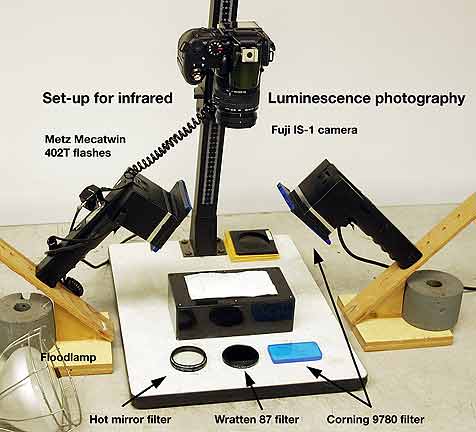 TThe flash heads were placed about 9
inches from the
surface of the
receipt. The camera used for this sample was a new Fuji IS-1 camera set
to manual mode. he lens on camera was covered with the Wratten 87 filter assuring that
only infrared would be transmitted on to the camera's sensor. The sensor speed was adjusted to 1600, the aperture to
f/3.4 and the exposure time to 1/800 second. The flash sync speed of
the camera is useable to 1/1000 second. This assured that any ambient
infrared there might be in the environment would be effectively
removed. Otherwise one would make the photographs in darkness or low
levels of fluorescent tube illumination since these emit very little to
no infrared.
TThe flash heads were placed about 9
inches from the
surface of the
receipt. The camera used for this sample was a new Fuji IS-1 camera set
to manual mode. he lens on camera was covered with the Wratten 87 filter assuring that
only infrared would be transmitted on to the camera's sensor. The sensor speed was adjusted to 1600, the aperture to
f/3.4 and the exposure time to 1/800 second. The flash sync speed of
the camera is useable to 1/1000 second. This assured that any ambient
infrared there might be in the environment would be effectively
removed. Otherwise one would make the photographs in darkness or low
levels of fluorescent tube illumination since these emit very little to
no infrared.As you can see from the sequence below the visible record was hardly readable. A photograph made with the receipt illuminated with a flood lamp containing copious amounts of visible and infrared and photographing through the Wratten 87 filter that was placed on the lens produced an essentially totally white result. This means the ink was very transparent to infrared. It behaved as if it was absent.
On the other hand, when the subject was lit by light from the flash heads covered by the infrared blocking, light transmitting, Corning 9780 filters, the residual ink from the cash register impression became easily visible and readable. It meant that the ink was reflecting infrared rays while the white paper on which the text was imprinted did not. This gave rise to the reversal of tones in the infrared luminescence photograph.
Admittedly the amount of light falling on the receipt was quite extreme. And the CCD of the camera had to be cranked up to its most sensitive state. Plus the lens aperture was at its widest. But this is a small price to pay for having "resurrected" the desired data from the otherwise visually blank sheet of paper!
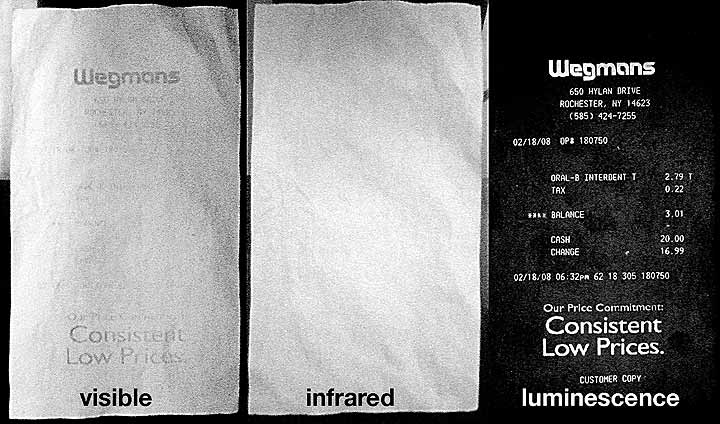
Going further we might examine other subjects with the same technique. Below is $10 bill and the infrared luminescence technique makes evident what are probably forgery prevention measures or simply identification markers included in the note.
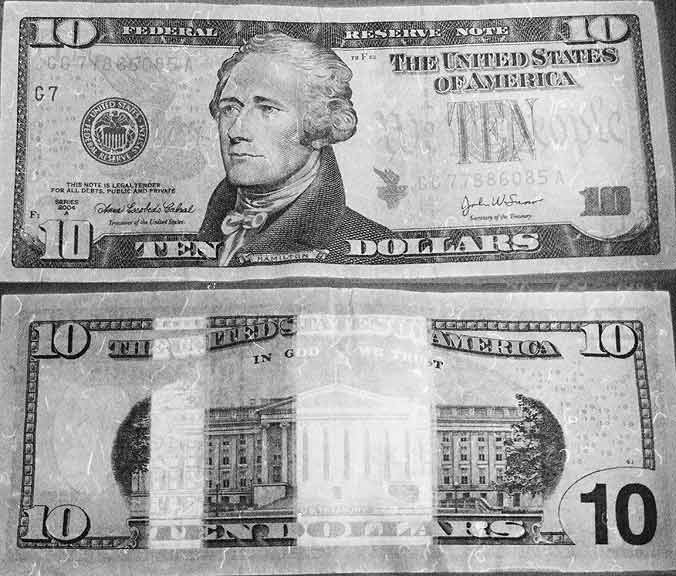
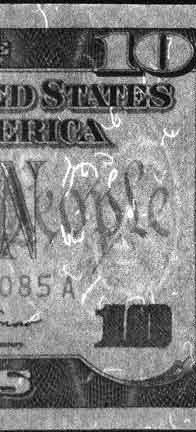 For example, as shown on the detail at right, luminescent fibers can be seen interwoven within the paper. These appear
like short, bright, threads which "fluoresce in the infrared" and are randomly dispersed
in the paper. Also on the side with the building one can see two broad bands extending
not quite totally across the bill. One notes also that within the luminescing band the columns of the building appear
in reverse tone. Since this is not an article about forgery prevention
or such things I will not venture beyond a guess but the assumption is probably a good one
that the bill has several other anti-forgery measures built in. It is just that this $10 note
is a good example of what hidden "messages" can be uncovered with rather a straightforward
technique.
For example, as shown on the detail at right, luminescent fibers can be seen interwoven within the paper. These appear
like short, bright, threads which "fluoresce in the infrared" and are randomly dispersed
in the paper. Also on the side with the building one can see two broad bands extending
not quite totally across the bill. One notes also that within the luminescing band the columns of the building appear
in reverse tone. Since this is not an article about forgery prevention
or such things I will not venture beyond a guess but the assumption is probably a good one
that the bill has several other anti-forgery measures built in. It is just that this $10 note
is a good example of what hidden "messages" can be uncovered with rather a straightforward
technique.
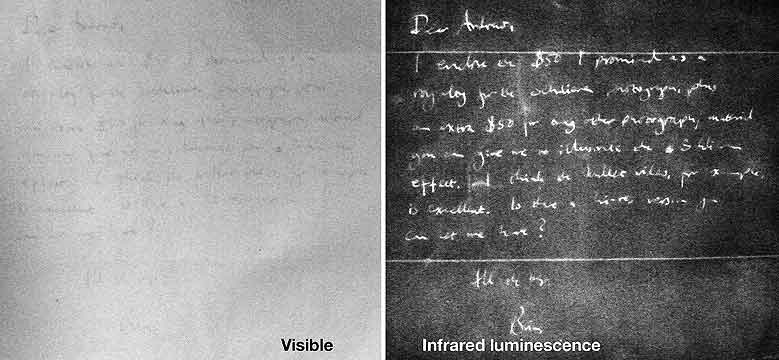 In this instance a letter written with pen and ink also suffered water damage to the point that it was quite illegible.
In this instance a letter written with pen and ink also suffered water damage to the point that it was quite illegible.
By photographing it with the light transmitted by the blue-green infrared blocking filter the residual ink in the paper fluoresced in the infrared and this was recorded by the camera looking at the document through a visually opaque Wraten 87 filter. While not exactly easy to read this is mostly due to the handwriting character or style and not so much to the fact textual information was lost.
In general, a record of a document in which the paper background is rendered black while the writing appears white is an indicator of the fact that the Infrared Luminescence technique was used.

The next example is one patterned directly after the work of H. Lou Gibson who did much work with infrared luminescence of woods. It is a record depicting a sample of hardwood in the visible, full color version. Then in the monochromatic B&W rendition made by photographing with the Fuji IS-1 through a "hot mirror" that did not allow any or hardly any infrared to pass into the camera. This is followed by the third view which was made with the Wratten 87 filter over the camera lens exploiting the infrared sensitivity of the camera since the 87 does not allow any visible light to pass and finally, the fourth record, depicts the appearance of the same piece of wood but as it fluoresces, or luminesces, in the infrared photographing still through the 87 filter but using the Corning 9780 filters over the flash heads. It is easy to deduce that the wood interacts quite differently when lit and photographed under various regimens. Often surprising results are produced!
When examining questioned documents Fluorescence in the infrared or Infrared Luminescence is a technique that ought to be considered when other approaches fail.
If you have questions about this technique for visualizing the invisible you can contact me, Andrew Davidhazy by email at andpph@rit.edu.
One question that I anticipate has to do with where to obtain the Corning 9780 or 9788 filter material. I bought mine from Corning directly but that was many years ago. These days several glass companies like Newport, PPG Optical and Schott probably sell the material either as polished filters for use in optical systems or as cast glass slabs. The latter are quite suitable for use over flash heads. I believe that there are also other filters that are the equivalent of the 9780. For this maybe Edmund Optics may be a supplier.
Note: You can see slightly larger views of the illustrations shown in this article by clicking on the images themselves.